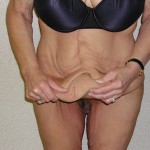
As the excess skin wraps around into the back so must the cutout pattern go. Unlike the more traditional tummy tuck where the scar stops at the front part of the hips, the extended tummy tuck scar goes further back. Whether it just goes slightly beyond the hip to almost to the middle of the back will depend on how much excess skin there is. If you can grab more than an inch or two between your fingers at your sides, there is too much skin. While in the traditional cosmetic patient, liposuction of this area may suffice, the loss of elasticity of this skin from weight loss makes its excision more predictable. Liposuction depends on skin shrinking (which happens poorly in the weight loss patient), cutting it out is guaranteed to make it tighter.
The decision to extend the tummy tuck further into the back is not a hard one. Whether to manage the vertical skin excess can be more difficult. Cutting out a strip of skin vertically can help tighten the waistline and smooth out any rolls at the side of the waist. Doing so creates an ‘anchor’ or fleur-de-lis type of tummy tuck, a vertical incision running down the middle of the stomach (from the end of the breast bone) to join with the low horizontal incision. This type of tummy tuck always produces a better overall result but the question is….is it worth the extra scar? If one already has a midline scar from their bariatric surgery, this decision is an easy one. But most bariatric surgeries done today use a laparoscopic approach, so fewer people are now seen with this scar. I leave this decision up to patient. In addition to the extra scar, the risk of postoperative fluid collections is higher (more underlying dead space), an extra drain is needed, and a potential for some wound separation at the junction of the inverted T is always possible. All of these issues, if they occur, are only temporary so the real issue to consider is the permanent vertical scar. In my experience, most bariatric or extreme weight loss patients are most interested in how they look in clothes first and foremost.
When the extra skin become so extensive that it literally wraps around the waistline and extends completely across the back (with sagging of the buttocks), the tummy tuck must be combined with a back or buttock lift. In essence, a front and back operation. This is known as a body lift or circumferential body lift.
Dr. Barry Eppley
Indianapolis, Indiana


